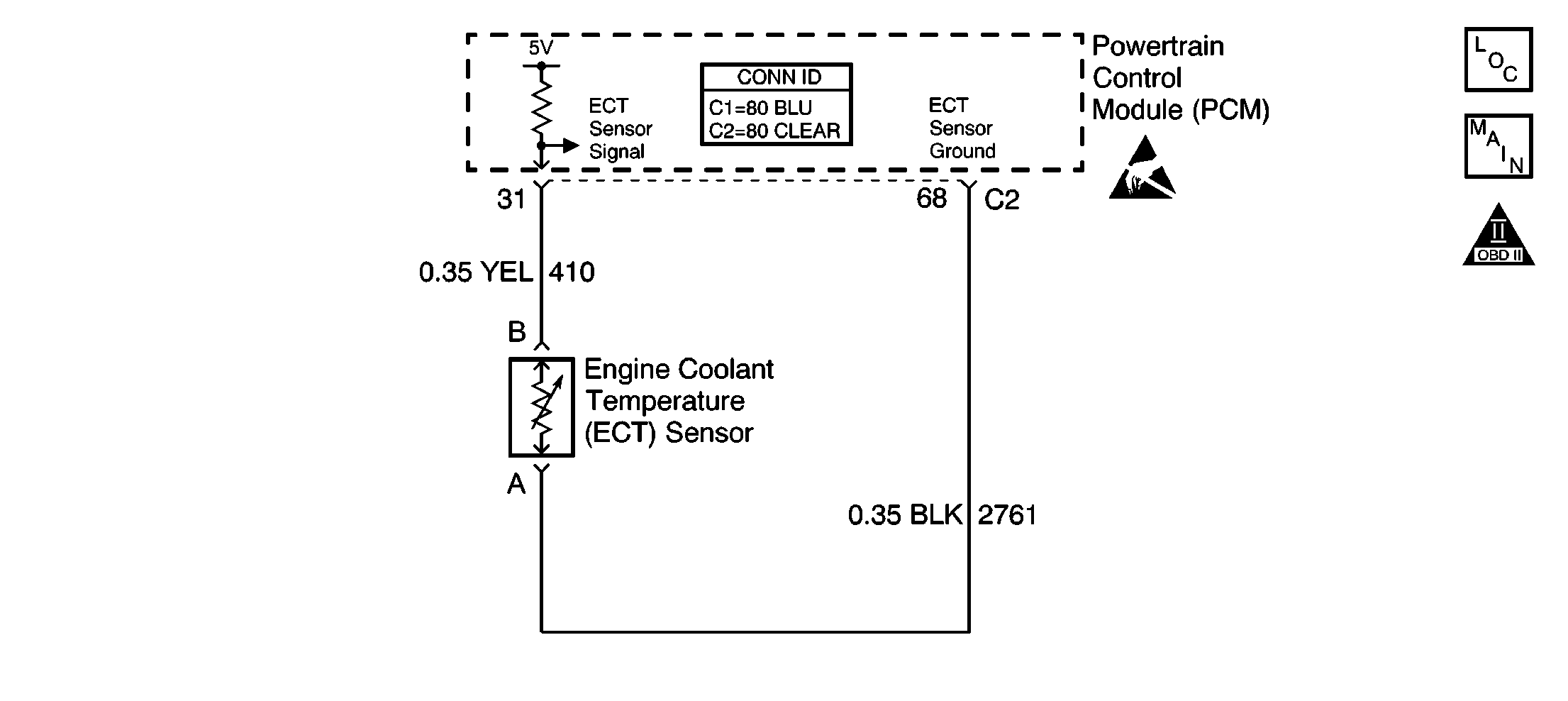
Circuit Description
The PCM uses a closed loop air/fuel metering system to provide the best possible combination of driveability, fuel economy, and emission control. When the vehicle is first started, the PCM controls fuel delivery in an open loop mode. The PCM ignores signal from the fuel control heated oxygen sensors (HO2S bank 1 sensor 1 and HO2S bank 2 sensor 1). The PCM calculates the air/fuel ratio from the engine coolant temperature, throttle position, and mass air flow sensors. The PCM uses the fuel control sensors to control fuel delivery (Closed Loop) when the following conditions are met:
| • | The PCM monitors the HO2S bank 1 sensor 1 and HO2S bank 2 sensor 1 voltage signals switching from below 300mV to above 600mV. |
| • | The engine coolant temperature sensor indicates an engine coolant temperature above 84°C (183°F). |
| • | Time since start-up is at least 10 seconds for a warm engine or 2 minutes for a cold engine. |
Conditions for Running the DTC
| • | ECT, IAT, MAF or VSS DTCs are not set. |
| • | Engine running. |
| • | Start-up ECT is less than 40°C (104°F). |
| • | Engine coolant temperature is more than -40°C (-40°F). |
| • | Intake air temperature is more than -40°C (-40°F) but less than 40.2 °C (104°F). |
| • | Vehicle speed is more than 1.6 km/h (1 mph). |
Conditions for Setting the DTC
The length of time for the engine coolant to reach a stabilized temperature of 68°C (154°F) takes longer than it should. The amount of time ranges between 2 and 23 minutes depending on engine coolant temperature at start-up and the amount of air cycled by the engine since start-up.
Action Taken When the DTC Sets
| • | The PCM illuminates the malfunction indicator lamp (MIL) during the second consecutive trip in which the diagnostic test runs and fails. |
| • | The PCM stores the conditions present when the DTC set as Freeze Frame/Failure Records data. |
Conditions for Clearing the MIL/DTC
| • | The PCM will turn the MIL OFF after the third consecutive trip in which the diagnostic runs and passes. |
| • | The history DTC will clear after 40 consecutive warm-up cycles have occurred without a malfunction. |
| • | The DTC can be cleared by using the scan tool Clear DTC Information function. |
Diagnostic Aids
| • | The cooling system coolant level. Refer to Loss of Coolant in Engine Cooling. |
| • | The thermostat operation. Refer to Thermostat Diagnosis in Engine Cooling. |
| • | The cooling fan operation. Refer to Electric Cooling Fan Diagnosis . |
| • | Check for high resistance in the wiring related to the ECT sensor. Also, check for poor connections at the ECT sensor and PCM. Refer to Wiring Repairs in Wiring Systems. |
| • | DTC P0125 may set due to a skewed ECT sensor. To help isolate this condition, compare the engine coolant temperature display on the scan tool with the actual coolant temperature measured with a thermometer. If the displayed engine coolant temperature value is not close to the actual coolant temperature, replace the ECT sensor. Refer to Engine Coolant Temperature Sensor Replacement . |
If the conditions is intermittent, refer to Intermittent Conditions .
Test Description
The number below refers to the number in the diagnostic table.
Step | Action | Values | Yes | No | ||||||||
|---|---|---|---|---|---|---|---|---|---|---|---|---|
1 | Did you perform the Powertrain On Board Diagnostic (OBD) System Check? | -- | ||||||||||
2 |
Does ECT increase to above the specified value within 2 minutes? | 68°C (154°F) | Go to Diagnostic Aids | |||||||||
3 | Are any of the following ECT sensor DTCs set?
| -- | ||||||||||
4 |
Are the cooling fans off? | -- | ||||||||||
5 | Check the cooling system coolant level. Is the coolant level OK? | -- | ||||||||||
Compare engine coolant temperature displayed on the scan tool to the actual coolant temperature measured with a thermometer. Is the scan tool engine coolant temperature indication within the specified value of the measured temperature? | ± 3°C (± 5°F) | |||||||||||
7 |
Did you find and correct the condition? | -- | ||||||||||
8 | Check for proper operation of the thermostat. Refer to Engine Fails To Reach Normal Operating Temperature in Engine Cooling. Is the thermostat operating correctly? | -- | ||||||||||
9 |
Did you find and correct the condition? | -- | -- | |||||||||
10 | Replace the loose terminals or repair malfunctioning wiring as necessary. Refer to Wiring Repairs in Wiring Systems. Is the action complete? | -- | -- | |||||||||
11 | Replace the ECT sensor. Refer to Engine Coolant Temperature Sensor Replacement . Is the action complete? | -- | -- | |||||||||
12 |
Does ECT increase to above the specified value within 2 minutes? | 68°C (154°F) | System OK |
